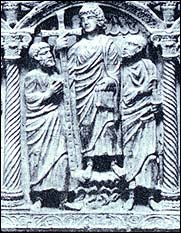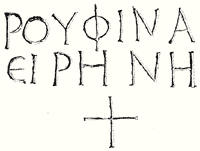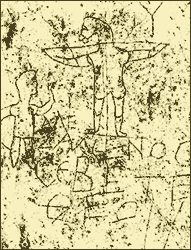
|
Old Testament
New Testament
Gospels
Acts
Paul's Letters
General Letters
Revelation
Topical Studies
Beginning the Journey (for new Christians). en Español

|
Old Testament
New Testament
Gospels
Acts
Paul's Letters
General Letters
Revelation
Topical Studies

|
Home
Bible Studies
Articles
Books
Podcasts
Search
Menu
Donate
About Us
Contact Us
FAQ
Sitemap
Cross as an Early Christian Symbol
 Cross on the sarcophagus of Sextus Petronius Probus and wife, Rome, ca. 390. |
Though in our day, the cross is the most common Christian symbol -- by far -- it was not always so.
The Cross in Christian Art and Monuments
During the period of persecutions before Constantine I, we generally don't find the cross on monuments and catacomb sepulchres. It is nearly always disguised -- as an anchor, later a trident, or the mainmast of a ship.1 Other disguised forms of the cross include monograms such as what is called the St. Andrew's cross, in the shape of the Greek letter chi. The Greek cross with equilateral arms appears in some catacomb inscriptions also. The Chi-Rho is seen early as well as the swastica. Even during a century relatively free from persecution after Constantine's Edit of Milan (313 AD) declaring Christianity a tolerated religion didn't make most Christians comfortable enough to display the cross. One of the first appearances of an undisguised cross is on the sarcophagus of Sextus Petronius Probus and his wife, Rome, about 390 AD. Another example is a sarcophagus probably from the Catacomb of Domitilla (mid-fourth century).
 Sarcophagus showing a carried cross and the Monogram of Christ (Chi-Rho) above a cross, in the Museo Pio Cristiano, Vatican, Rome, probably from the Catacomb of Domitilla (mid-fourth century). |
 The simple Greek cross (+) is found below the inscription of Rufinus and Irene, catacombs, early third century.4 |
Occassionally you can see a simple Greek cross (+) on gravestones in the catacombs of Jerusalem, Malta, and Rome. However, the undisguised cross, with a few exceptions, first appears in the early years of the fifth century.
Sign of the Cross
This doesn't mean that the early Christians neglected the cross. Apparently the custom of making the sign of the cross on one's forehead was widespread fairly early. Tertullian wrote about 204 AD:
"At every forward step and movement, at every going in and out, when we put on our our clothes and shoes, when we bathe, when we sit at table, when we light the lamps, on couch, on seat, in all the ordinary actions of daily life, we trace upon the forehead the sign." (The Chaplet/De Corona 3.4).
 Second century pagan graffito depicting a man worshipping a crucified donkey. The inscription reads: "Alexamenos respects God," presumed to be making fun of a Christian soldier. (Museum on the Palatine Hill, Rome. Even Tertullian had to defend against this kind of abuse: "For, like some others, you are under the delusion that our god is an ass's head." (The Apology, 16.1). |
But pagans made fun of Christian devotion to the cross. Tertullian defended Christianity against the pagan claim that they were "a priesthood of a cross" (Tertullian, To the Nationes 1.12) and rendering "superstitious adoration to the cross." (Tertullian, The Apology 16.6).
- The Christian Chapel--Herculaneum. Although there is some disagreement, most archaeologists believe that this room served as a place of worship for Christians, then considered a heretical cult. The cross apparently was carried away by the householder during the disaster. Volcanic mud still covers the altar.
- Greek Cross Monogram (The Salina 5 hypogeum), Malta.
Crucifix
The earliest example of the crucifix, a carved representation of Christ attached to the cross is from the late sixth century.2
Celtic Cross
I am fascinated by the old stone Celtic crosses in Scotland and Ireland
References
- A fascinating article on the history of the cross is found in Orazio Marucchi, "Archaeology of the Cross and Crucifix," Catholic Encyclopedia (1908), vol. 4).
- Philip Schaff, "The Cross and the Crucifix," History of the Christian Church, vol. 2, § 77.
- C.M. Kaufmann, Early Christian Inscriptions, Catholic Encyclopedia (1910), vol. 8.
- Tim Dowley (ed.), Eerdmans' Handbook to the History of Christianity (Lyons, 1977), p. 56.
Copyright © 2025, Ralph F. Wilson. <pastor![]() joyfulheart.com> All rights reserved. A single copy of this article is free. Do not put this on a website. See legal, copyright, and reprint information.
joyfulheart.com> All rights reserved. A single copy of this article is free. Do not put this on a website. See legal, copyright, and reprint information.


 To be notified about future articles, stories, and Bible studies, why don't you subscribe to our free newsletter, The Joyful Heart, by placing your e-mail address in the box below. We respect your
To be notified about future articles, stories, and Bible studies, why don't you subscribe to our free newsletter, The Joyful Heart, by placing your e-mail address in the box below. We respect your